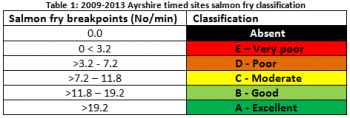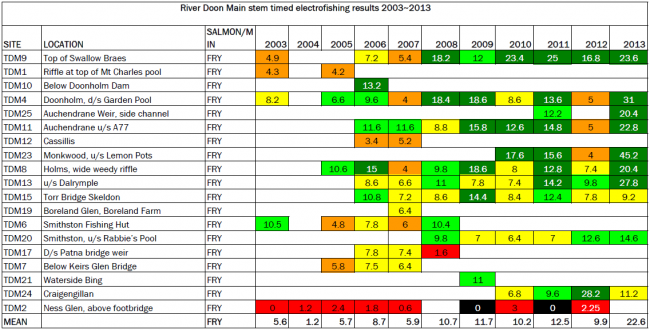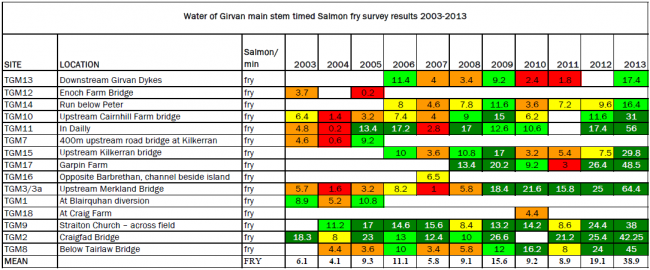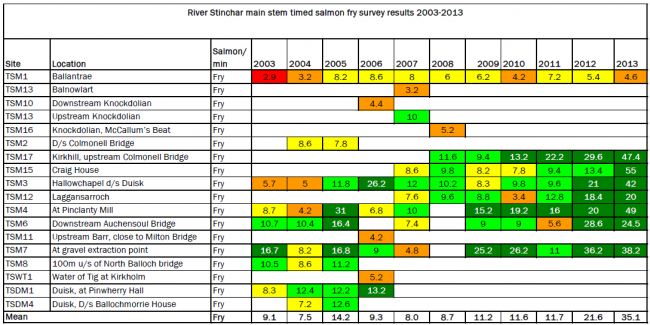As the weather has remained dry, Stuart has been out electrofishing with a team comprising mainly of Helen and Struan. At the beginning of each annual electrofishing season we start with the timed sites, as contrary to popular belief salmon do spawn in the main stem of the rivers and not just their tributaries. Given the importance of the main stem for salmon production we established a system of timed electrofishing sites in 2003/4. The monitoring technique involves a team of three electrofishing in an upstream direction in run/riffle habitat for five minutes, using a banner net to capture the fish. These surveys are always carried out in low water conditions (where possible) during July and beginning of August.
Over the years some of the sites have been dropped and new ones established due to unsuitable habitat or difficult surveying conditions. Rivers substrates are never completely stable and high spate conditions can move large deposits of gravel creating new spawning areas, but in the same instance destroy original spawning grounds.
Based on the results over the previous five years ART have developed a classification system for salmon fry based on a five way (quintile) split of the results. The classification has been colour coded to highlight the results. The new classification for 2013 is shown in the table below.
The results from the four monitored rivers over the time series are shown below. The sites in each table are ordered in an upstream direction; the first site in each table is the one nearest the sea. The mean (average) number for each year is shown in the bottom row.
It should be clear from the tables above that the abundance of salmon fry in the River Ayr is quite different to the other three rivers. Overall for 2013 the River Ayr salmon fry main stem average is in the moderate category, whereas the Doon, Girvan and Stinchar are all in the excellent category. However this is the best result we have had on the Ayr since the timed surveys began in 2004, but heavily relies on the upper catchment to produce good numbers as the lower catchment continues to be poor.







Thanks for posting this so quickly Gillian. These are great results and I’m very encouraged to see a slight improvement on the Ayr at long last. Hopefully this will continue. The Doon and Stinchar results are really very good but the Girvan results are just fantastic.
I agree with you Stuart, Girvan results are excellent!! Let’s hope river Ayr improves as well 🙂
Hi hope the better results on the ayr continue and you can work out whats going on in the lower reaches .well done the more knowledge we have the better our chances of helping
Have you looked at the whitaugh burn downstream of the Greenock .I see a lot of fish spawning there
And always thought after the Greenock it could be the most important nursery up there(sometimes called the garple)
Keep up the good work guys it’s appreciated
George,
we were on the Whitehaugh earlier this week. No salmon above the falls as expected, but a good population of trout. Downstream of the falls salmon were recorded in good numbers. This is bound to produce quite a few smolts each spring however, there isn’t an awful long stretch available to salmon and for this reason I expect the Garple (the other one at Muirkirk) may produce more fish. We will be fishing that one shortly to see how it is performing.
The lower river suffers from the cumulative effects of all the agricultural and industrial inputs that happen along the length of the river. I expect that some experimental gravel cleaning late in the season may improve egg survival and spawning success. The Trust hopes to deliver these actions later this year if adequate funding is forthcoming (we have applied for funding for a research project on the Ayr and Lugar but this has been unsuccessful, twice already. Third time lucky I hope!